Current electric unit with activities plans & lab pages
Historical learning cycle plan
- Big ideas, concepts, facts, & outcomes
- Content concepts, facts, & outcomes
- Anticipated learner thinking & misconceptions
- Process - explanation, model, & more concepts, facts, & outcomes
- Scoring guide suggestions
- Pedagogical overview
- Unit activities sequence
- Unit resources & materials
- Lesson plans
- Activity 1 - Static review
- Activity 2 - Simple circuit - bulb, wire, & battery challenge
- Activity 3 - Circuit tester - conductor & non conductor
- Activity 4 - Batteries in series & parallel
- Activity 5 - Light bulbs in series & parallel
- Activity 6 - Resistance
- Activity 7 - Make a switch
- Activity 8 - Test an electrical puzzle and make an electrical puzzle
- Activity 9 - Electricity & magnetism
- Activity 10 - Electro scale
- Lab notes
- Lab 1 - Static review
- Lab 2 - Simple circuit - bulb, wire, & battery challenge
- Lab 3 - Circuit tester - conductor & non conductor
- Lab 4 - Batteries in series & parallel
- Lab 5 - Light bulbs in series & parallel
- Lab 6 - Resistance
- Lab 7 - Make a switch
- Lab 8 - Test an electrical puzzle and make an electrical puzzle
- Lab 9 - Electricity & magnetism
- Lab 10 - Electro scale
- Support materials
Activities to investigate electricity & the transfer to light, heat, & magnetism
Last edited - August 1, 2025
Overview
A middle level study of current electricity.
Historically the scientific study of electricity falls into four broad areas:
- Early study of static electricity. (pre 1800's)
- Use of primitive, human sized, materials (metals and insulators) to create electrical ciruits with sources and receivers. (1800's-1950's)
- Semiconductors, transitors and non quantum computing. (1950's - )
- Superconductor, semiconductor to merge signal gain, frequency conversion, of electrial and magnetic fields and the use of quibits and quantum computing.
Activities mainly focus on the use of materials (metals, insulators) to create electrical circuits with sources and receivers. However, to integrate a historical perpective, references to scientists who studied electricity within related activities, are referenced. For example the first activity is included to provide an opportunity to reference early contributions from the study of static electricity; for example by Ben Franklin with his contributions about static electricity. The focus moves to understand current electricity in a simple closed circuit (bulb, battery, & wire) by creating a model that explains electrical energy transfer from source to receiver. Explorationd continue with multiple sources & receivers in parallel and series, then resistance and electro magnetism. Among the last activities (space ball includes a transistor to explore how a circuit could be closed with small amounts of electricity) provide opportunities to motivate further exploration and study of transitors, semiconductors and beyond.
Some activities inspired by the sixth grade physical science models module from the science curriculum improvement study (SCIS). This unit is expanded with a historical perspective of science and the inclusion of other science processes as suggested by Marlene Storms and Candi Coventry.
Background resources
- Learning cycle instructional method
- Human development of intellectual thinking - tasks to use with learners across all ages, directions, materials, variety of responses with explanations.
- Learning theory - how humans learn from infant to adult. A constructivist model with a Piagetian base. Includes learning procedure, flow chart, variables that effect learning, what changes & doesn't change, explanations for children's thinking as naive understandings or misconceptions, physical activities that develop intelligence, logic and other thinking skills. Explains development over time.
- Magnetism explorations
- Additional static electricity explorations
- May want learners to have done some model activities.
Planning information
Learner background knowledge
A plan designed for learners who have prior knowledge in cause and effect, use of observations to make inferences, models as explanations for non observable events, and working in groups.
Intended learnings & learners thinkings
See for more information on what to include in general planning
Content concepts or outcomes
(Source concepts & misconceptions)
Big ideas and specific outcomes:
- Electricity is energy that can be stored as a source and transferred through a receiver within a circuit.
- Electrical circuits require a complete loop through which an electrical current can pass. Electricity in circuits can transfer electrical energy to light, heat, magnetism, & motion energy.
Concepts and facts
Electricity in a closed circuit flows through the circuit and transfers energy to the receiver.
- Energy can be transferred from electricity to light.
- Electrical circuits require a complete circuit through which an electrical current can pass through a source and receiver.
- A closed circuit is created with a continuous path through the: (1) top of the battery, (2) bottom of the battery, (3) bottom of the bulb, and (4) threaded side of the bulb.
- Battery has electricity, it has terminals one a metal bump on top, and bottom with a metal plate
- Wire has plastic coating with metal (copper) inside the wire
- Light bulb has a metal tip on the bottom, metal threads on the side, glass on the top with a filament inside.
- Light bulb lights when electricity passes through the bulb
- Energy transfered by the flow of electricity includes transfer of energy as light, magnetism, heat, motion...
- Conductor is
- Nonconductor is
- Switch opens and closes a circuit
- Batteries in series cause
- Batteries parallel cause
- Bulbs in series cause
- Bulbs in parallel cause
- Resistance is
Outcome
Make simple electric circuits and describe how electricity flows through them.
Anticipated learner thinkings & misconceptions
Light bulbs and batteries have no interactions.
Energy flows from the battery to the light bulb like water from a hose.

There must be a circle for the energy to flow.

There are not enough objects in the system to light the bulb.
- Each circuit is unique and there are no common elements among different circuits.
- Models are like pictures.
- Systems can not be understood.
- No relationship of receiver and source.
- Source makes a receiver work like Wi-Fi
- Electricity flows like water from the source to the receiver
- Electricity flows through the wire as a circuit with the receiver attached.
Inquiry, process, & cross cutting concepts & skills
Evidence, explanation & model
Big ideas: Model. See also Concepts & misconceptions
Models are representations of a real object or system
that can be used to explain and predict how a system interacts.
Related concepts and facts
- Observational data and reasoning is used to explain interactions. Evidence is something that
is observed and can be used to understand what is happening and make predictions
about future changes.
- Models are structures that correspond to real objects, events, or classes of
events.
- Explanations are based on observation derived from experience or experimentation and are understandable.
- Pictures or symbols represent objects.
- A symbol represents an energy source and receiver.
- Energy transfer is represented by a continuous path.
- The continuous path must enter and leave both the receiver and source.
- The pattern described or illustrated in the model can be transformed in part and not changed in other parts.
- Essential parts of the system are two terminals on the battery and two terminals on the bulb.
Outcome - model
- Make a model of an electric circuit and use it to predict the flow and energy transfer in different circuits.
- Explain a model is a way to illustrate and explain what can't be seen, but can be inferred from observations.
Specific outcomes -
- Explain a model is a way to illustrate and explain what can't be seen, but can be inferred from observations.
- The bulb will light. If I just keep varying the positions of the objects a method of lighting the bulb can be found through experimentation.
Other possible concepts
Constancy, change, and measurement
- All groups systems work the same. Brightness of bulb can vary with different bulbs and strength of battery
- Constancy of the bulb, battery, and wire system.
- Change of electricity to light.
- Change in amount of electricity in the system over time.
- Change in the amount of light produced in time
Evolution and equilibrium
- Transfer of energy will continue until there is an equilibrium.
- Conservation of energy as there is a transfer from electricity to heat to light ...
Form and function
- Shape, material, and organization of different parts determine how the battery, bulb, and circuit work.
History of science and development of technology - perspective of science
See also Concepts & misconceptions also science, math, technology timeline
- People have practiced science and technology for a long time.
- Science develops over time.
- Science investigators such as Franklin, Edison, ... contributed to what we know today.
- Ben Franklin, Michael Faraday and Thomas Edison are three early scientists that studied electricity and its components.
- Ben Franklin explored electricity, lightning, lightning rod, lyden jar.
- Edison built an electrical distribution system. How to connect multiple receivers.
- Edison improved the light bulb.
- Michael Faraday designed the first electromagnetic generator.
Scoring guides suggestions (rubric)
Electricity (scoring guide)
Top level
- A closed circuit has a continuous path for electricity to travel from a source to a receiver through the receiver where it transfers energy and then leaves the receiver and travels back to the source. (closed circuit)
- Electricity travels to a receiver if there is a continuous closed path for it to flow from the source through the receivers and back to the source.
- Electricity travels in a circle.
- Electricity is energy that flows to a receiver, like a light bulb.
Lower level
Model (scoring guide)
Top level
- A model is a picture or 3-d object that can be used to represent a real object or system to explain what it is, how it works, and can be used to predict how it interacts in certain situations.
- Model is an explanation
- Model is a picture of something.
Lower level
Strategies to achieve educational learnings
Based on learning cycle theory & method
Instructional Procedure
Pedagogical Overview
Activities Sequence to provide sufficient opportunities for students to achieve the targeted outcomes.
Make sure learners have the prior knowledge identified in the background information.
- Activity 1 - Static review - if want more exploration of static electricity
- Activity 2 - Simple circuit - bulb, wire, & battery challenge - See professional development information for a learning cycle and planning
- Activity 3 - Circuit tester - conductor & non conductor
- Activity 4 - Batteries in series & parallel
- Activity 5 - Light bulbs in series & parallel
- Activity 6 - Resistance
- Activity 7 - Make a switch
- Activity 8 - Test an electrical puzzle and make an electrical puzzle
- Activity 9 - Electricity & magnetism
- Activity 10 - Electro scale
- Circuit puzzles or challenges
- Flash Light Challenge
Focus question
Unit focus question:
How do you light a light bulb?
Sub focus questions:
- How are people responsible for electricity?
- What is electricity?
- What is the importance of electricity?
- How is electricity created?
- How do we use observation to gather evidence to create understanding?
- How models help us understand and explain?
- What different kinds of circuits are there?
- Why do some things have more than one battery?
- How are lights wired in light strings and in houses?
- How are electricity and magnetism related?
- How does a three way switch work?
- How does a toaster heat?
- What is the difference between a light bulb with a filament and an LED?
Resources and Materials
- Lab notes
- Lab 1 - Static review
- Lab 2 - Simple circuit - bulb, wire, & battery challenge
- Lab 3 - Circuit tester - conductor & non conductor
- Lab 4 - Batteries in series & parallel
- Lab 5 - Light bulbs in series & parallel
- Lab 6 - Resistance
- Lab 7 - Make a switch
- Lab 8 - Test an electrical puzzle and make an electrical puzzle
- Lab 9 - Electricity & magnetism
- Lab 10 - Electro scale
- Circuit puzzles or challenges
- Flash Light Challenge
- Support materials
Lesson Plans
Activity 1 - Static review
Additional static electricity explorations
Materials:
Note: static electric is highly effected by humidity. Low humidity days would be best for exploring it. Avoid rainy gloomy days.
- tape, thread, balloons, tissue paper, rice crispy cereal, Styrofoam
peanuts, wool cloth, markers, glass rod, straw, lab sheet, comb, dripping water (if available) ...
Focus questions:
- Who knows about Ben Franklin and his contributions from his study of electricity?
- What is static electricity?
- What are ways you have explored static electricity ?
Learning outcomes:
- Learners describe their current understanding about their uses of electricity.
- Summarize Benjamin Franklin’s contributions to the understanding of electricity.
- Demonstrate how objects become electrically charged.
- Observe, predict and test the effects of static electricity.
- Explain objects can be charged so they can either have an attractive or repellent force.
Suggested procedures overview:
- Review what learners know about their uses of electricity.
- Summarize Benjamin Franklin’s contributions to the understanding of electricity and relate his Leyden jars to batteries.
- Introduce static electricity.
- Put students in groups, focus their attention, and assess their initial understanding of the focus questions.
- Challenge the learners to explore static electricity and collect information to better understand it.
- Share results.
- Share idea that static electricity is difficult to understand with all the variables that affect it. Thus it was very difficult for Ben to make a lot of progress toward using electricity the ways we are able to today.
- Suggest current electricity in circuits has reduced the number of variables to consider and is easier predict what it will do.
- Complete lab notes.
Exploration (Explore, Focus, Engage, Categorize)
- Ask. How do you use electricity each day?
- List all responses.
- Provide an overview of the unit. Start with a brief review or introduction of static electricity and move to current electricity to learn about the basic properties of electricity. Closed circuit, open circuit, different kinds of circuits, how electricity is used to provide light, heat, motion, ...
- Introduce a bit of historical science background.
- Who knows about Ben Franklin and his contributions from his study of electricity? Everyone probably has heard about his kite experiment, but he also invented the lightning rod, and tried to store electricity in a jar (laden jar).
- Franklin realized lightning had a lot of energy and could be valuable if it could be harnessed. Therefore, the importance of his explorations of laden jars to store electricity for continuous and delayed use.
- Ask. Has anyone ever been lying in bed and looked under a blanket as you lifted it up and down? Did you see a lightning show? Well not really lightning, maybe more a static electricity show. suggest they try it sometime. OR
- Have you walked across a carpet and touched something metal and got .... zapped?
- Suggest, let's start an investigation of electricity with static electricity.
- Put learners in groups.
- Show them the static material for each group to explore. (thread, tissue paper, Styrofoam peanuts, wool cloth, balloons, ... )
- Tell them they are going to explore with the materials and design a simple experiment to conduct and share the results.
- Demonstrate how to rub the glass rod, plastic straw, or balloon with the different fabrics (silk, wool, etc.).
- Tell them they can move the rod toward different objects (tissue paper, Styrofoam, cereal, balloons, hair, shirts, chair, desk, etc. ) on top of a table or attached to thread suspended from the desk.
- Describe how different objects suspended on the thread interact when different materials are moved toward them.
- Suspend dried cereal or balloons close to each other and see if they can be charged to attract or repel each other.
- Work in cooperative groups to explore static charges and design a simple experiment to demonstrate to class.
Invention (Invent, Construct, Negotiate, Explain)
- Share experiments.
- Chart results on a class chart of various experiments.
- Discuss if the objects attract, repel, or don't interact.
- Ask. Is there a patterns in the results?
- Describe them.
- Write an explanation of what happens. Some objects can be made to have a static charge that can interact with other objects that have a static charge by attracting, repelling, or creating a spark.
- Ask. How do scientists understand static electricity?
- Ask. How do observations help you understand?
- Ask. How do you use their understandings?
- What did you learn about static electricity?
- Share idea that static electricity is difficult to understand with all the variables that affect it. Thus it was very difficult for Ben to make a lot of progress toward using electricity the ways we are able to today.
- Suggest current electricity in circuits has less variables that affect its flow and it is easier to predict what it will do.
- Suggest they will begin to see the difference when they study a simplest closed circuit with a battery, bulb, and wire.
- Complete lab notes.
Discovery (Translate, Elaborate, Extend)
Discovery can continue with static electricity or with this plan, move to current electricity.
Modified from - Marlene Storms and Candi Coventry
Activity 2 - Simple circuit - a bulb, wire, & battery
Materials: bulb, wire, D battery



See professional development information for this activity (learning cycle & planning)
Focus questions:
- How would you light a bulb with one wire and one battery?
Learning outcomes:
- Write an operational definition for a simple closed circuit.
- Use an operational definition, experience with the bulb & battery circuit, and logic to make a model for the energy transfer in the closed circuit.
Suggested procedures overview:
- Put learners in pairs, focus their attention, and assess their initial understanding of the focus questions.
- Challenge them to light a light bulb with one wire and one battery as many ways as they can.
- Share & discuss results.
- Write an operational definition for a simple closed circuit.
- Share
- Complete lab notes.
- Challenge them to use their model and make closed circuit with a motor.
Exploration (Explore, Focus, Engage, Categorize)
- Introduce a bit of historical science background.
- Ben Franklin and others tried to find a way to use electricity, but it wasn't till others like Edison were able to find uses, such as providing light.
- Hold up a bulb, one wire, and battery.
- Ask. How would you light a bulb with one wire and one battery?
- Ask. What will you do if your first idea doesn't work?
- Share their ideas with the class, but do not tell what will or won't work.
- If learners want to discuss why they think one will or will not work, then let them.
- Don't give away a solution.
- Give one wire, battery, and light bulb to each learne or pairs.
- Challenge them to light the bulb as many different ways as they can.
- When they do, encourage them to find more ways to light the bulb.
- If they can not light the bulb, have them explain the strategy they are using and try to get them to abandon the strategy and try another. (decenter)
- Encourage them to draw diagrams of their circuits.
Invention (Invent, Construct, Negotiate, Explain)
- Bring the class together.
- Have them draw and label the circuits they tried, as lit the bulb or didn't light the bulb.
- Display all so all can see them.
- Discuss them.
- Ask. What do they all have in common? bulb is touching the battery, wire is touching the bulb and battery. Four places are being touched: bottom of bulb,side of bulb, top of battery, bottom of battery
- List the similarities for the circuits that lit the bulb.
- Ask. How can we describe how the circuit needs to be connected to light?
- Let them write their description.
- Tell them their description is an operational definition for the kind of circuit that lights a bulb - closed circuit.
- Ask. Why it would be called that. It describes how something (closed circuit) operates.
- Have them compare their operational definition to:
- A closed circuit for a flashlight bulb, battery, and wire system is created with a continuous path (closed circuit) with the following parts in the path: (1) top of the battery, (2) bottom of the battery, (3) bottom of the bulb, and (4) threaded side of the bulb.)
- Have them modify their description, if they desire and write an operational definition for a closed circuit.
- If the following diagrams were drawn, when circuits were shared, refer to them. If not, then say. Here are a couple of circuits I saw people try. Using your operational definition, predict if they were closed and why you believe they are or are not.
- Ask. Could use your model: of a continuous closed path with four connections for electricity to flow through to get a motor to operate.
- Quickly pair or group according to the number of motors you have.
- Pass out a motor to each group.

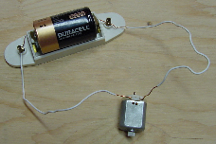
Discovery (Translate, Elaborate, Extend)
- Let each group explore how to make a circuit so the motor works.
- Cruise the room offering encouragement and hints by using the operational definition they wrote and asking if there are points on the motor, kind of like the points on the light bulb, to connect like the model for the light bulb?
- After all groups are successful, bring them together to discuss.
- What strategies did you use?
- What other strategies might be used?
- Ask. Are there changes that should be made to your model so it includes information for a motor?
- Review their models
- Have students make circuits with more objects. Have students make a closed circuit for a circuit tester and test objects to see if they close the circuit (concept of conductor and non conductor).
- Ask. What is the difference between explaining electricity in this simple circuit to explaining static electricity?
A closed circuit has a continuous path for electricity to travel from a source to a receiver through the receiver where it transfers energy and then leaves the receiver and travels back to the source. (closed circuit)
Activity 3 - Circuit tester - conductor & non conductor
Materials:
- Bulb, battery, two wires, light bulb holder, battery holder, materials to test - assortment of small items made of various materials (plastic, wood, metals (copper, aluminum, steel, silver, gold jewelry), glass, paper clips, brass fastener,
Focus questions:
- What is a circuit tester?
- How could you make one?
- What kinds of materials can be used to close a circuit?
Learning outcomes:
- Make a circuit tester.
- Review safe daily use of electricity. Safe to use small batteries (D, AA, AAA, 9V) Do not every experiment with electrical current in homes.
- Review how electricity flows in a circuit.
- Classify common material as conductors or non conductors.
- Describe metals will conduct electricity and many non metals are non conductors. Many, which can be used as insulators.
Suggested procedures overview:
- Put students in groups, focus their attention, and assess their initial understanding of the focus questions.
- Review electricity safety.
- Make a circuit tester.
- Use the circuit tester to test different materials and classify them as light the bulb or not.
- Display the data, share, discuss, classify, and draw conclusions about what types of materials close the circuit (metals) and don't (non conductor).
Exploration (Explore, Focus, Engage, Categorize)
- Mention. Since you are exploring electricity, what should you know about safety with electricity?
- Review electricity safety. Safe to make circuits with small batteries (D, AA, AAA, 9V) Never experiment with electrical appliances or electrical current in homes.
- Review your operational definition of a closed circuit.
- How does electricity flow in one?
- If there is a closed circuit and there isn't a light bulb in it, how would you know it was closed?
- If there was some material a person was considering to include in a circuit, how would they know if it would make the circuit closed or open?
- Ask. What is a circuit tester?
- How can we make a circuit tester? A circuit tester an be made with a wire going from the battery to the bulb, another wire from the bulb hanging loose, and another wire connected to the other end of the battery hanging loose so that when the two loose ends are joined, the light bulb lights.
- Discuss plans.
- Ask. How would electricity move in this circuit plan?
- When ready, continue to ...
- Make a circuit tester and test different materials and determine which will close a circuit and which will not.
- Provide the collection of materials and let them move around the room and test different items in the room.
- Test the objects and record the object, whether the circuit was open or closed, whether
the bulb was lit or not, and the material the object is made of.
Invention (Invent, Construct, Negotiate, Explain)
- Display data so all can view.
- Classify by materials that close the circuit (conductors) and don't (non conductor).
- Share terms.
- Ask what are the properties of the different materials.
- Conductors are mostly metals. (copper, silver, gold, iron, steel) non conductors (chalk, plastic, cotton, polyester, rubber, ... )
- Ask. What is the importance of a conductor?
- What is the importance of non conductors?
- Connect non conductors to insulators.
- How do we use conductors and insulators?
Discovery (Translate, Elaborate, Extend)
- Move to excite about exploring circuits with multiple receivers and sources.
Original - Marlene Storms and Candi Coventry
Activity 4 - Batteries in series and parallel
Materials:
![]()
Focus questions:
- What kinds of circuits can be made with two sources?
- List properties of electricity and its safe daily use.
- Historically what contributions did scientists contribute to the current knowledge and use of electricity today. Edison built electrical distribution system. How to connect change flow.
- Build and trouble shoot multiple circuits, circuit tester.
- Describe how electricity flows in different circuits.
Learning outcomes:
- Describe batteries in parallel and series circuits and suggest why there are differences in the energy transferred to a bulb.
- Sources in series seem to increase the energy proportionally.
- Sources parallel seem to distribute the same amount to a receiver.
Suggested procedure overview:
- Put learners in groups, focus their attention, and assess their initial understanding of the focus questions.
- Share drawing of circuit with two batteries.
- Diagram two more circuits with two batteries. (series & parallel)
- Make the circuits and collect data to make a model and infer about the energy transfer.
- Complete lab notes.
Exploration (Explore, Focus, Engage, Categorize)
- Put learners in groups of two or three.
- Review how they constructed a simple circuit.
- Suggest they will be exploring more complex circuits.
- Ask. What happens if two batteries are used in a closed circuit?
- How should additional batteries be added?
- Have them draw different ways two batteries can be put into a closed circuit?
- Display all suggestions.
- May want to introduce symbols for battery and light bulb.
- Hopefully they will suggest batteries connected in series and parallel. If not offer hints as the possibility of other connections and suggest ways to logically determine whatever is missing. What other position might be used to make a closed circuit?
- Discuss how to make and collect data for each circuit.
- If the following hasn't been included, then suggest the following be added to the list.
- Hopefully they will question the placement.
- They will probably want to try it. Tell them they can. After they use their model to suggest if it will or will not transfer energy.
- Discuss reasons for it being a closed and open circuit.
- Have everyone check to make sure they have each possible circuit drawn in their notes so they can record their observations.
- Have learners make the different circuits, try them, and record their observations with a diagram of each of the circuits.
![]()



Invention (Invent, Construct, Negotiate, Explain)
- Use the circuit drawings and add the observable results for each.
- Discuss and make conclusions about how the energy is being transfered in the different circuits.
- Review what that a model can be used to describe something that isn'’t observable.
- Ask. How can your model be edited to include ideas for these circuits?
- Ask. Does their observations support their model?
- If not ask them how they should change their model. Continue for all groups.
- Give some non examples. Light bulb will light. However, one battery is a source one is not.
- Ask the learners importance of knowing circuits and how they work.
- Ask the importance of models.
- Ask how scientists study electricity.
- Ask how scientists use observation and explanations of models.
- Ask how they can use what they have learn.
- Add to or modify their model and record in their notes.
- Complete their lab notes.

Discovery (Translate, Elaborate, Extend)
- Ask. Can you suggest different kinds of circuits with light bulbs?
- They will share their ideas to start the next activity.
Activity 5 - Light bulbs in series and parallel
Materials:
- Bulbs, batteries, wires, bulb holders, battery holders, notes
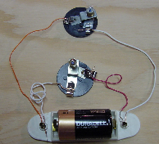


Focus questions:
- Historically what did scientists contribute to the current knowledge and use of electricity today? Edison built an electrical distribution system. How to connect multiple receivers. Edison improved the light bulb. Michael Faraday designed the first electromagnetic generator.
- What kinds of circuits can be made with two receivers (bulbs)?
Learning outcomes:
- Describe bulbs in parallel and series circuits and suggest why there are differences in the energy transferred to the bulb.
- Receivers in series seem to receive less energy for each additional receiver.
- Receivers parallel seem to receive the same amount of energy as if they were in their own circuit.
Suggested procedures overview:
- Put students in groups, focus their attention, and assess their initial understanding of the focus questions.
- Share drawing of circuit with two bulbs.
- Diagram two more circuits with two bulb. (series & parallel)
- Make the circuits and collect data to make a model and infer about the energy transfer.
- Complete lab notes.
Exploration (Explore, Focus, Engage, Categorize)
- Put learners in groups of two or three.
- Ask. What historically contributions of scientists to electricity have you discovered and remember? Edison built electrical distribution system. Yesterday see how the amount of electricity could change and needed to be controlled. Today explore how to connect multiple receivers.
- Review how they constructed circuits with batteries.
- Suggest they will be creating more complex circuits by adding multiple receivers.
- Ask. What are different ways two bulbs can be put into a closed circuit?
- Draw all suggestions.
- Discuss how to make and collect data for each circuit.
- Explore and collect data and draw diagram examples of each of the circuits.
Invention (Invent, Construct, Negotiate, Explain)
- Share data.
- Modify or add to model for electricity.
- Ask what would happen if three bulbs.
- Try some and share...
Discovery (Translate, Elaborate, Extend)
- Ask. Did you notice any difference between bulbs when they are added to each kind of circuit (parallel and series).
- What differences there are in series and parallel circuits?
- Why do the bulbs get dimmer when more are added to a circuit?
- Suggest resistance. Mention explore it next.
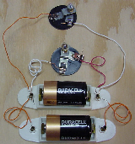
Activity 6 - Resistance
Materials:
- nichrome wire, circuit tester, bulb, batteries, wires, bulb holders, battery holders, notes
- clay, nichrome wire, glass jar
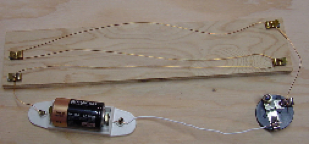
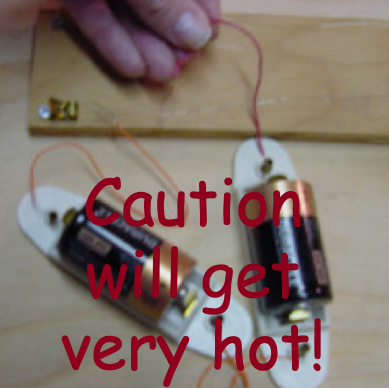
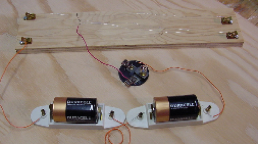
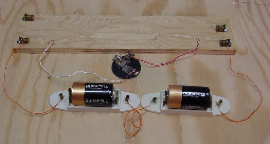
Focus questions:
- What happens to the electricity in a circuit as more receivers are added?
- Is a wire a conductor?
- Do different kinds of wires conduct electricity differently?
- Is a wire a receiver?
- What happens to the circuit tester when more and more wire is added to the circuit?
- Are there different kinds of wires?
- Why does the wire in a toaster get so hot?
- What contributions did Edison have to do with electricity?
- How does an incandescent light bulb work?
Learning outcomes:
- Resistance causes energy to be transfered as heat to the nichrome wire and reduce the amount available to other receivers in the circuit.
- Describe contributions of scientists to the current knowledge and use of electricity today.
Suggested procedures overview:
- Put students in groups, focus their attention, and assess their initial understanding of the focus questions.
- Discuss what happened to the brightness of the bulb in different circuits,
- Explore brightness of a bulb as the wire gets longer. First copper, then nichrome.
- Develop concept resistance.
Exploration (Explore, Focus, Engage, Categorize)
- Put learners in groups of two or three.
- Ask. Focus questions.
- What happened when more light bulbs were added to the circuit in series? they got dimmer.
- What happens to the electricity in a circuit as more receivers are added? it is distributed among the receivers.
- Is a wire a receiver that uses electrical energy? yes ... heat
- What happened to the wire when there was a short circuit? it got warm.
- What do you think happens to a circuit tester if more and more wire is added to the circuit?
- Are there different kinds of wires?
- Why does the wire in a toaster get so hot?
- Share boards with lengths of wire on them to test.
- Demonstrate or discuss how learners will participate in an exploration with different lengths of copper wire and different lengths of nichrome wire in a circuit with a bulb?
Possible exploration sequence of wire ...
Wire in series circuit with bulb and battery:
- Set up the following system. Leave the longer wire attached to the light bulb holder loose. Touch it to the terminal where the wire from the battery is attached to the copper wire. Notice the brightness of the bulb. Slide the wire along the copper wire attached to the board. Notice if the brightness of the bulb changes. There will be little if any change in brightness. Copper is the third best metal conductor. Gold is best, followed by silver.
- Set up the same kind of system only with nichrome wire. system. Again, use the longer wire, attached to the light bulb holder loose. Only this time touch it to the terminal FARTHEST from where the wire from the battery is attached to the nichrome wire. Notice the bulb will NOT light. Slide the wire along the nichrome wire attached to the board. Notice when the bulb begins to light. Be CAREFUL the closer it gets to the other end, the HOTTER the nichrome wire will get. Nichrome wire has a lot of resistance, which heats the wire.
- Set up the same kind of system only this time attach both wires from the bulb between the connections of the battery's connections to the nichrome wire. The bulb ma or may not light. Slide the one wire from the light bulb along the nichrome wire. If the bulb is not light, move the wires from the bulb closer. Notice how the brightness of the bulb changes with the length of nichrome wire between the end. Be CAREFUL the closer they get to each other on the nichrome wire, the HOTTER the nichrome wire will get. Nichrome wire has a lot of resistance, which heats the wire.




Resistance is very important in electric circuits. It can be used to control the flow of electricity in different ways. Can introduce resistance, resistors, mention Ohm's Law Voltage (E) = current (I) resistance (R) Introduction of the electro scale in later lessons can be used as an indicator of the energy in a circuit. Alternatively a volt ohm meter could be used to determine these different measurements.
Invention (Invent, Construct, Negotiate, Explain)
- Ask. How does an incandescent light bulb work?
Discovery (Translate, Elaborate, Extend)
Ask. What contributions did Edison have to do with electricity? A lot. Focus on his experiments to make a light bulb that would not burn out in a few hours. He also organized the first electric company and distribution of electricity.
To ensure safety the following can be done with a teacher supervised demonstration.
- Show a large light bulb with the base removed.
- Point out the way the wires come through the light and connect to the base.
- Have learners draw and label the parts of a bulb. Ex. Glass, filament, support wires, lead wires, stem, base contact, threaded cap contacts (cap), gas, ...
- Ask. What is the importance of each part of a bulb?
- Place lump of clay on desk, push 2- 30 cm pieces of wire into clay so that 10 cm of wire is standing straight up.
- Wrap a piece of nichrome wire around each 10 cm wire end creating about 1 cm gap between the 10 cm hook up wires.
- Next, place the jar over the connected wires BEFORE connecting the 2 batteries to the wires. CAUTION: Nichrome wires will glow orange hot with smoke. Do not leave the batteries connected too long or batteries will drain.
- Ask. What is a procedure we are going to follow?
- What precautions need we take to do the activity?
- Review the procedure and if safe connect the circuit and observe...
- Ask learners to explain. What is happening in the circuit?
- Have them use the following words in their explanation: closed circuit, transfer, energy, electricity, heat, light,
Explore a magic ping-pong ball or space ball.
How does it work? What closes the circuit? How much resistance is there between two fingers? What kind of switch turns it on?
Activity 7 - Make a switch
Materials:
- Battery, bulb, battery holder, light bulb holder, assorted materials for making a switch (paper clip, aluminum foil, ...
Focus questions:
- How can you make a switch that will open and close a circuit?
Learning outcomes:
- List properties of electricity and its safe daily use.
- Describe contributions of various scientists to the current knowledge and use of electricity today.
- Describe how electricity flows in a circuit.
- Make a plan to create a switch.
- Make a switch.
- Build a circuit and alter it with switches.
Suggested procedures overview:
- Put students in groups, focus their attention, and assess their initial understanding of the focus questions.
- Challenge the learners to create a plan to make a switch that will open and close a circuit.
- Plan.
- Share plans.
- Implement plan and make switch and try it in a circuit.
- Complete lab notes.
Exploration (Explore, Focus, Engage, Categorize)
- Put learners in groups of two or three.
- Tell then to make a plan for the construction of a switch that will open and close a circuit.
- Plan
- Share plans.
Invention (Invent, Construct, Negotiate, Explain)
- Make a switch, put it in a circuit, test, and resolve any problems.
- Share switch by demonstrating and explaining how it operates.
- Have them explain how the electricity moves in each circuit with the switch.
- Edit their model and explain how it now includes a switch.
Discovery (Translate, Elaborate, Extend)
- Ask. How can we use the switch? model how light switches are used in the classroom, home, and other places, How do you use a switch in a one switch circuit? Two switch circuit? to turn on a circuit for an electro magnet?
- Have the learners build a circuit using multiple bulbs, wires, two batteries, and a switch to open and close their circuit.
- Then draw a diagram of the circuit with all its elements and use your model to explain how the wiring fits the observations.
- When completed, bring them together to share.
- Ask each group to demonstrate their circuit and use their model to judge the other learner's explanations of how it works..
- Have the presenting group to use explain if their model supports the other explanations for their observations.
- If not ask them how they should change their model. Continue for all groups.
- Ask. Is it helpful for you to know about circuits and how they work?
- What is the importance of models?
- When do people need to know about electricity?
- How do we use observation, explanations, and models?
- How can you use what they have learn?
Activity 8 - Test an electrical puzzle and make an electrical puzzle
Materials:
- Circuit puzzle direction sheet
- Directions for circuit puzzle with magnetic reed switch
- Battery, bulb, wire, battery holder, light bulb holder, assorted materials for making circuit puzzles: poster board, aluminum foil, masking tape, hole punch, alligator clips.
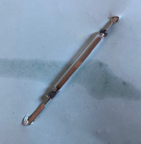
Focus questions:
- How can you solve a circuit puzzle?
- Can you make a circuit puzzle?
Learning outcomes:
- Review contributions of various scientists to the current knowledge and use of electricity today.
- Build and trouble shoot multiple circuits, circuit tester.
- Describe how electricity flows in a circuit.
Suggested procedures overview:
- Put students in groups, focus their attention, and assess their initial understanding of the focus questions.
- Challenge the learners to create a plan to make a switch that will open and close a circuit.
- Plan.
- Share plans.
- Implement plan and make switch and try it in a circuit.
- Complete lab notes.
Exploration (Explore, Focus, Engage, Categorize)
- Put learners in groups of two or three.
- Demonstrate a circuit puzzle.
- Share circuit puzzle directions.
- Have learners make puzzle framework and plan on how to create their own
- Make a puzzle and name it.
- Exchange puzzles and create a model for two or three.
Invention (Invent, Construct, Negotiate, Explain)
- Share puzzle designs and discuss different models.
- Ask. Have you ever heard of an electronic quiz board?
- Let me explain how you can make one.
Discovery (Translate, Elaborate, Extend)
Explain:
- First, decide on a topic or think of 8-10 questions and short word answers.
- For example. Could write them about scientists that you learned about. Who is the scientist who explore Leyden jars? Or science facts. What is a source of electricity? battery
- Write or word process sentences or questions. Then make a list of the word or phrase answers.
- Arrange questions or sentences on the left side of a board.
- Randomly arrange the answers on the right side of the board.
- Punch holes beside each question and answer.
- Use a strip of aluminum foil to connect each question on the left to its answer on the right on the back of the board.
- Make sure each piece of foil is visible, on the front side, through each hole.
- Cover the foil strip on the back with tape. Be sure it is covered so when another piece of foil is place and it cross one, it will not make a short circuit.
- Continue placing foil strips from question to answer.
- Use a circuit tester to test and trouble shoot the quiz board as you assemble it.
- When complete check the arrangement to see that only the correct answer lights when the circuit tester touches the question and answer.
- Exchange with others and enjoy!
Activity 9 - Electricity & magnetism
Background & extension magnetism activities
Materials:
- battery, battery holder, switch, coil of wire, magnets, rivet or other iron core, paper clips, compass,
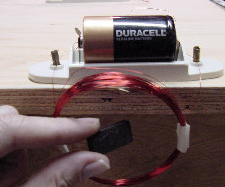
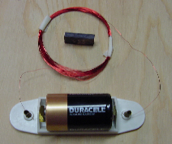
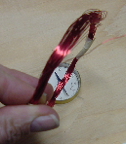
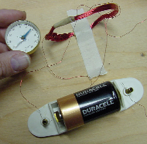
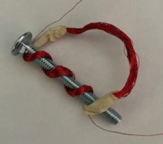
Focus questions:
- How does electricity and magnetism relate?
- What does a magnetic field around the flow of electricity look like (if you could see it)?
Learning outcomes:
- Describe contributions of various scientists to the current knowledge and use of electricity today.
- Construct an electromagnet.
- Use scientific methods to design original experiments with electricity, and experiment with variables using electricity magnets.
- State a relationship between the strength of an electromagnets and the flow of electricity (number of coils) along an iron core.
- Determine how magnetism is created and interacts with objects.
Suggested procedures overview:
- Put students in groups, focus their attention, and assess their initial understanding of the focus questions.
- Tell the learners they are going to explore magnetism and electricity.
- Have them make a circuit with the coil of wire so the switch will open and close it.
- Have them explore the coil with a magnet and compass.
- Explore
- Share results
- Complete lab notes.
Exploration (Explore, Focus, Engage, Categorize)
- Put learners in groups of two or three.
- Ask. What contributions of scientists to the current knowledge and use of electricity today do you know of?
- Ask. What do you know about magnets?
- Pass out magnets for free exploration.
- Ask the students characteristics of magnets. (Ex. Strength, size, weight etc.)
- Ask the students how magnets can be compared according to strength.
- Ask the students to describe the difference between a magnet and an electromagnet.
- Pass out the materials.
- Students build electromagnets following written directions.
- Begin by connecting a circuit using 1 battery, 2 wires, 1 switch, and 1 bolt.
- Make the long wire into a coil by wrapping it around your bolt.
- Connect the ends of the loop back to the circuit. Touch the bolt to the pile of paper clips.
- Ask the students to describe what they see.
- Ask the students to predict what will happen.
- Live the bolt with the switch closed.
- When the bolt begins to feel warm, open the switch to break the circuit.
- Ask the students to describe what they have created.
- Ask the students how an electromagnet works.
- Ask the students to explain the importance for electromagnets.
- Ask the students how they will use what they have learned.
Tell the learners they are going to explore magnetism and electricity.
Have them make a circuit with the coil of wire so the switch will open and close it.
Have them explore the coil with a magnet and compass. May want to observe and remind as necessary: To keep the circuit open when not exploring as the coil as the battery will transfer a lot of its energy to the coil.
Explore
May suggest:
- Lay the coil on the desk.
- Set the magnet inside the coil.
- Close the circuit.
- What do you observe?
- Try different positions for the magnet.
- What results do you observe?
- Hang the coil along the side of a table or desk.
- Close the circuit
- Move the compass around the coil.
- Draw how the compass needle is positioned as you move it around the coil.
Invention (Invent, Construct, Negotiate, Explain)
- Share results.
- Draw a diagram to represent a magnetic field around the coil of wire.
Discovery (Translate, Elaborate, Extend)
- Ask. Where do we use electricity and magnetism? generators, motors, ...
- Challenge learners to continue their exploration of electricity and magnetism.
Activity 9b - Explore Electromagnets
Materials:
- battery, battery holder, switch, coil of wire, magnets, rivet or other iron core, paper clips or washers to use as weights

Focus questions:
- How do electro magnets work?
Learning outcomes:
- Construct an electromagnet.
- Describe a model for the metal core being a magnet when the circuit is closed and not being a magnet when the circuit is open.
Suggested procedures overview:
- Put students in groups, focus their attention, and assess their initial understanding of the focus questions.
- Tell the learners they are going to explore electromagnets.
- Have them make an electromagnet with a coil of wire, and check out its magnetic properties when the circuit with the coil of wire is open and closed.
- Explore
- Share results
- Explore the power of electromagnets related to the number of coils.
Exploration (Explore, Focus, Engage, Categorize)
- Put learners in groups of two or three.
- Ask. How would youi make an electromagnet?
- Demonstrate how to wrap the coil around the bolt or rivet (iron core).
- Explore how it is magnetic when the circuit is closed and not when the circuit is open.
Invention (Invent, Construct, Negotiate, Explain)
- Share results.
- Draw a diagram to represent the particles or electron spin inside the iron core (bolt) when the circuit is open and closed. The arrows show the particles aligned and not aligned or the direction the electrons spin as aligned or not aligned. Arrows can also be drawn to show the magnetic field around the coil and around the bolt.
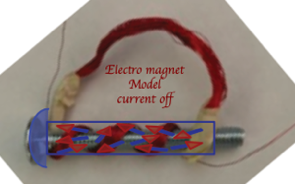
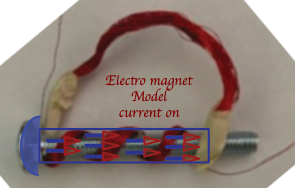
Discovery (Translate, Elaborate, Extend)
- Ask. How could we find a relationship for the number of turns and the amount of objects that could be picked up with this electromagnet? Put one coil aroiund the bolt and see how many washers it can pick up when the circuit is closed. Then put two coils around it and see how many washers it can pick up when the circuit is closed. Then try three, four, five, and maybe six if it can be squeezed on.
- Groups collect data, display for class to see, discuss record, graph, and discuss.
Activity 10 - Electro scale
Materials:
- battery, battery holder, switch, coil of wire, magnets, rivet or other iron core, paper clips, compass,
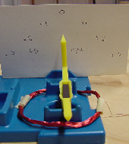
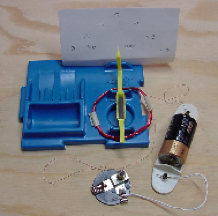
Focus questions:
- How do we measure electrical energy?
Learning outcomes:
- Describe contributions of various scientists to the current knowledge and use of electricity today.
- Construct an electro scale
- Use it to measure electricityin circuits.
Suggested procedures overview:
- Put students in groups, focus their attention, and assess their initial understanding of the focus questions.
- Tell the learners they are going to explore magnetism and electricity.
- Have them make a circuit with the coil of wire so the switch will open and close it.
- Have them explore the coil with a magnet and compass.
- Explore
- Share results
- Complete lab notes.
Exploration (Explore, Focus, Engage, Categorize)
- Put learners in groups of two or three.
- Ask. What contributions of scientists to the current knowledge and use of electricity today do you know of?
- Ask.
Invention (Invent, Construct, Negotiate, Explain)
- Share results.
- Draw a diagram to represent .
Discovery (Translate, Elaborate, Extend)
- Ask. Where
Lab Notes for activities
Activity 1 - Static exploration
Materials:
Static materials: tape, thread, balloons, tissue paper, rice crispy cereal, Styrofoam peanuts, wool cloth, markers, glass rod, straw, lab sheet, comb, dripping water (if available) ...
How do you use electricity each day?
Who do you know that has contributed to what we know about electricity?
What is static electricity?
Describe what objects interacted at a distance and how each was charged.
Object -
rubbed with
Object -
rubbed with
Together interacted by
Object -
rubbed with
Object -
rubbed with
Together interacted by
Summary - What did you discover about static electricity?
Activity 2 - Simple circuit - a bulb, wire, & battery
Materials:
For each person or pairs - bulb, wire with insulation removed from 1-2 cm on each end, & battery
Challenge:
Light the bulb. Draw each systems you try and label them as lit or unlit.
How many ways can you light the bulb?
Write an operational definition for a closed circuit.
What else did you learn?
Activity 3 - Make a circuit tester & test different materials
Materials:
Bulb, battery, two wires, light bulb holder, battery holder, materials to test - assortment of small items made of various materials (plastic, wood, metals (copper, aluminum, steel, silver, gold jewelry), glass, paper clips, brass fastener,
Review your operational definition of a closed circuit?
If there is a closed circuit and there isn't a light bulb in it, how would you know it was closed?
If there was some material a person was considering to include in a circuit, how would they know if it would make the circuit closed or open?
What is a circuit tester?
Design a circuit tester.
How will electricity move in your tester?
Make a circuit tester.
Test ten different materials and determine which will close a circuit and which will not.
Object - circuit open or closed, material the object is made of
What are the properties of the materials that closed the circuit?
What are the properties of the materials that did not close the circuit?
What is the importance of a conductor?
What is the importance of non conductors?
What is an insulator?
What kinds of materials might make good insulators?
What did you learn that could change your model for electricity?
What else did you learn?
Activity 4 - Batteries in series and parallel circuits
Materials:
battery, battery holder, switch, wires, bulb holder, bulb
Draw at least three different ways two batteries might be connect in a closed circuit to light a bulb.
Make each circuit and record your observations. (bulb: out, dim, medium, or bright)
Have learners make the different circuits, try them, and record their observations with a diagram of each of the circuits.
Describe how these observations support your model.
Describe any additional information, about circuits, you can add to your model.
Sources (batteries) in series will
Sources (batteries) parallel will
What else did you learn?
Activity 5 - Light bulbs in series and parallel
Materials:
battery, battery holder, switch, wires, bulb holder, bulb
Think about the different ways batteries were connected in the previous circuits and use the pattern to to draw circuits with two light bulbs.
Draw at least three different ways two light bulbs might be connect in a closed circuit to light.
Make each circuit and record your observations. (bulb: out, dim, medium, or bright)
Describe how these observations support your model.
Describe any additional information, about circuits, you can add to your model.
Receivers (light bulb) in series will
Receivers (light bulb) parallel will
What else did you learn?
Activity 6 - Resistance
Materials:
battery, battery holder, wires, bulb holder, bulb, nichrome wire,
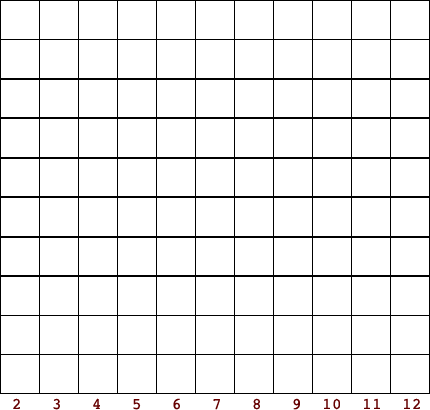
What else did you learn?
Activity 7 - Switch
Materials:
Battery, bulb, battery holder, light bulb holder, assorted materials for making a switch (paper clip, aluminum foil, ...
Make a plan for the construction of a switch that will open and close a circuit.
Add an operational definition to your model.
What else did you learn?
Activity 8 - Test an electrical puzzle and make an electrical puzzle
Materials:
Battery, bulb, battery holder, light bulb holder, assorted materials for making a switch (paper clip, aluminum foil, ...
Use the plan below to make a circuit puzzle, give it a name, and exchange with another to solve.
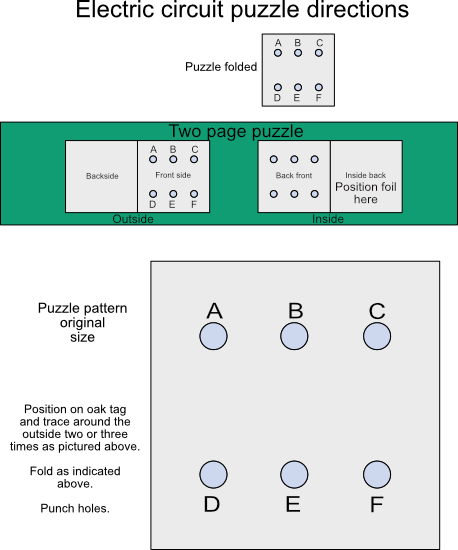
Draw model for puzzle ______________
Activity 9 - Electricity & magnetism
Materials:
battery, battery holder, switch, coil of wire, magnet, compass,




Make a circuit with the coil of wire, battery, and switch so the circuit can be opened and closed. Keep the circuit open when not exploring as the battery will transfer a lot of its energy to the coil.
- Lay the coil on the desk.
- Set the magnet inside the coil.
- Close the circuit.
What do you observe?
Try different positions for the magnet.
What results do you observe?
- Hang the coil along the side of a table or desk.
- Close the circuit
- Move the compass around the coil.
Draw how the compass needle is positioned as you move it around the coil.
What else did you learn?
Activity 9b - Electri0magnet
Materials:
battery, battery holder, switch, coil of wire, magnet, washers

Challenge
Make a circuit with the electromagnet, battery, and switch so the circuit can be opened and closed. Keep the circuit open when not exploring as the battery will transfer a lot of its energy to the coil.
What happens when the circuit is closed and open?
Draw a model to show the difference in what happens to create a magnetic field.
Electromagnet with an open circuit
Electromagnet with a closed circuit
Explore magnetic field strength.
Make an electromagnet and experiment to see how magnetic strength is changed with the number of coils. Graph your data and class data.
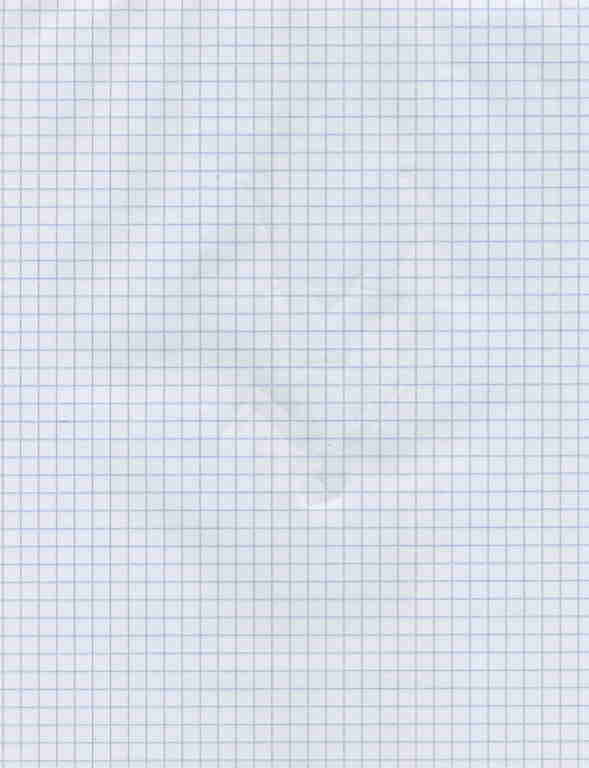
Activity 10 - Electr0scale to measure electric energy
Materials:
battery, battery holder, switch, coil of wire, magnet, compass,
Electro scale


What else did you learn?
Support materials
Sample directions for 4 Challenges:
The following circuits puzzle challenge or operational definition can be given as a challenge to the learners to make a circuit to achieve the conditions.
- Sample solution - Circuit puzzle sample for challenge to use magnetism to open and close a circuit
- Operational definition: Create a switch so that a magnet can be used with it so the magnet will open and close the circuit.
- Sample solution - Circuit puzzle with 2 switches, battery, & 2 bulbs
- Circuit puzzle challenge: Predict what happens when each combination of switches, in the circuit diagram) is open and closed. Or
- Operational definition: The sample circuit with a switch with 2 switches, 1 battery, & 2 bulbs is wired so that ...
- Sample solution - Circuit puzzle with 2 switches, battery, & 1 bulb
- Operational definition: The sample circuit with 2 switches, 1 battery, & 1 bulb is wired so that - Each switch will turn the light bulb on and off when both are on (the light will light), if both are off the light will be off, if either is on, the light will light, and if both are off the light will be off.
- Circuit puzzle challenge: Predict what happens when each combination of switches, in the circuit diagram) is open and closed.
- Sample solution - Circuit puzzle with bulb, battery, 2 switches, & 5 wires
- Operational definition: The sample circuit with with 1 bulb, 1 battery, 2 switches, & 5 wires will light a bulb when either switch is switched and turn off the bulb when either switch is switched.
- Circuit puzzle challenge: Make a circuit that can be operated by two switches to open and close a circuit (light a bulb).
- Circuit puzzle challenge: What is the least amount of materials needed to create a switch that can be operated to open and close a circuit (light a bulb)? 5 wires, 1 battery, 1 bulb holder, 2 switches
Circuit puzzle sample for challenge to use magnetism to open and close a circuit
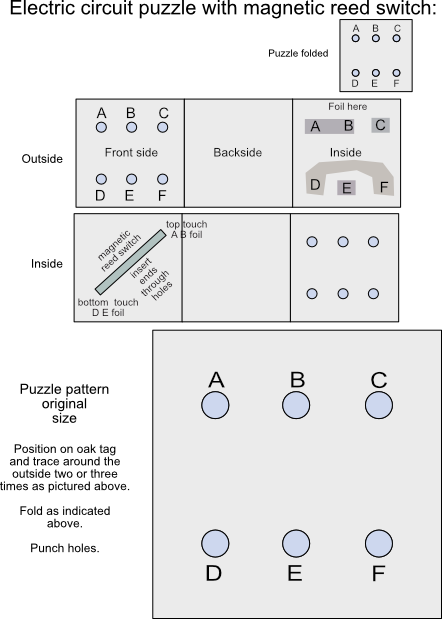
Circuit puzzle with 2 switches, battery, & 2 bulbs
Predict what happens when each combination of switches is open and closed.

| Switch left | Switch right | Bulb left | Bulb right | |
|---|---|---|---|---|
| Combination 1 | Open | Open | ||
| Combination 2 | ||||
| Combination 3 | ||||
| Combination 4 |
Circuit puzzle with 2 switches, battery, & 1 bulb
Predict what happens when each combination of switches is open and closed.

| Switch left | Switch right | Bulb | |
|---|---|---|---|
| Combination 1 | Open | Open | |
| Combination 2 | |||
| Combination 3 | |||
| Combination 4 |
Circuit puzzle with bulb, battery, 2 switches, & 5 wires
Predict what happens when each combination of switches is open and closed.
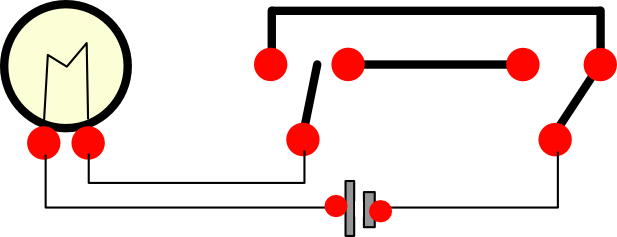
| Switch left | Switch right | Bulb | |
|---|---|---|---|
| Combination 1 | Center | Center | |
| Combination 2 | Left | ||
| Combination 3 | |||
| Combination 4 | |||
| Combination 5 | |||
| Combination 6 |
Flash light challenge
Challenge is to make a flashlight.
Decide what paramaters or rules to meet or follow.
For example no rules or flashlight that will rate best as sustainable and environmental friendly, inexpensive, and functional.
| Environmentally friendly | Functional | Cost | |
| Light bulb | |||
| Energy source | |||
| Flash light materials |
Three charts to suggest these parameters. Source: Science & Children. July/August 2025.
Chart to suggest parameters for of light bulb type
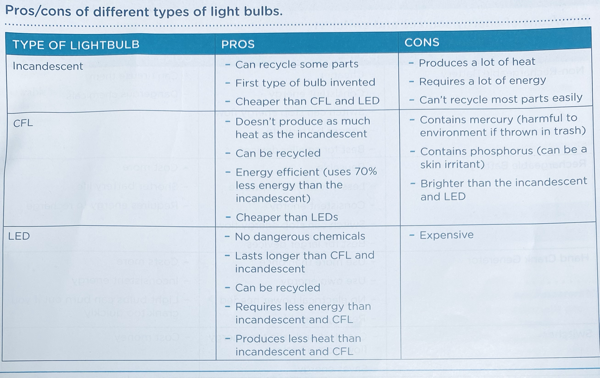
Chart to suggest parameters for energy source and switches
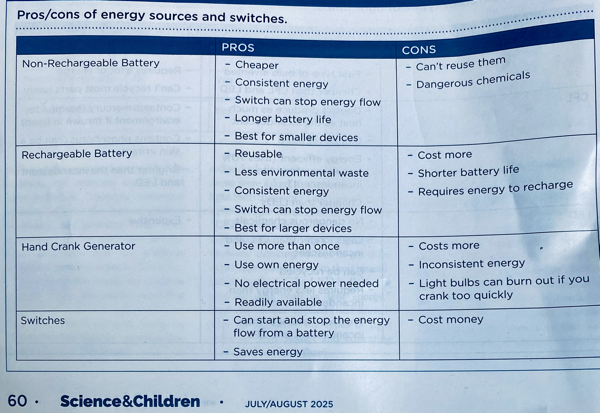
Chart to suggest parameters for materials and cost
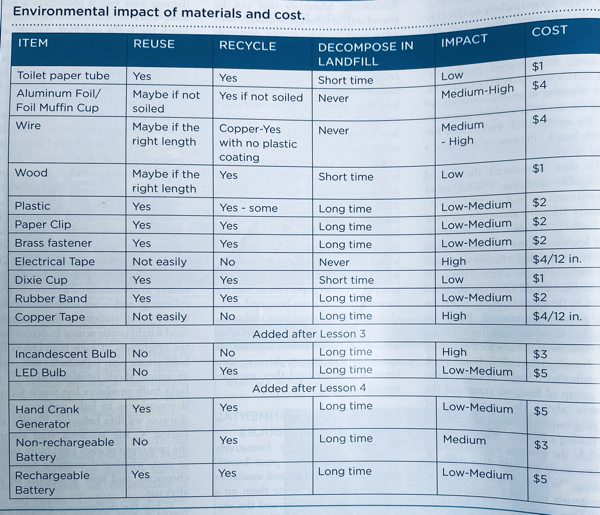
Home: Pedagogy - theory, curriculum, learning, human development, & teaching
Home: Science - knowledge base, activities, pedagogical knowledge in all dimensions